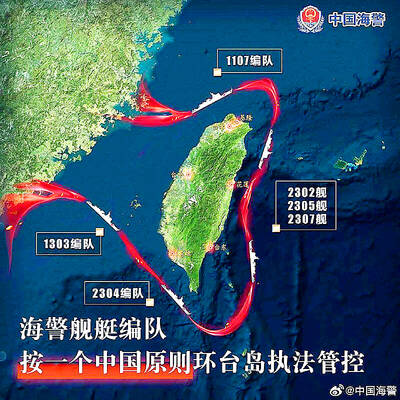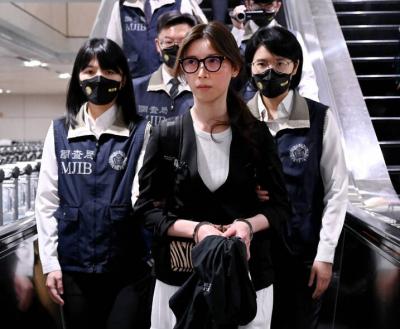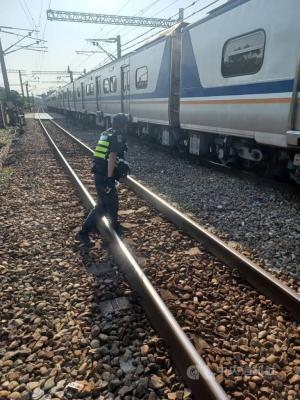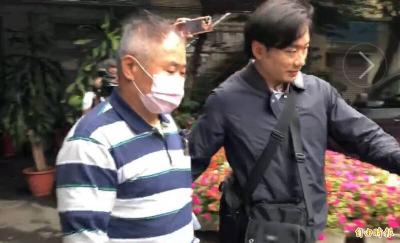The Atomic Energy Council (AEC) said yesterday it was confident it would quickly discover the source of a radioactive rod that was found at a steel works last week.
"Whether the radioactive waste was disposed of arbitrarily by a local firm that uses radioactive materials or by an illegal importer, we will have an answer soon," AEC Chairman Ouyang Min-shen (歐陽敏盛) said at a press conference yesterday.
Last week, the AEC was called to a steel works to investigate the discovery of the radioactive rod in metal scraps on a truck. The 28.28kg cesium-137 (Cs-137) cylinder, 10cm wide and 35.5cm long, was immediately sent to the AEC's Institute of Nuclear Energy Research (INER).
Officials said that researchers at the INER will cut the cylinder into pieces to check for serial numbers.
AEC officials said that so far they had no idea where the highly radioactive rod came from.
The rod emits 270 micro Sieverts per hour. The recommended radiation exposure in any one year for a member of the public, as recommended by the International Commission on Radiological Protection, is 1 milli Sieverts.
For someone who works with radioactive materials the limit is 20mSv a year.
AEC officials yesterday refused to release the name of the steel works where the rod was found but confirmed it as one of 19 that operates melting furnaces.
AEC officials said that the Cs-137 rod, with a boiling point of 6710C, would evaporate in a furnace and seriously pollute the environment.
The AEC is responsible for regulating all nuclear materials including those for medical use. The most significant source of man-made radiation exposure to the public is from medical procedures, such as diagnostic X-rays and radiation therapy. These procedures use Cs-137 among others.
"This unexpected find should have not happened because any licensed firm using radioactive materials would know that the waste cannot be dumped without reporting to the AEC in advance and getting permits," Su Ming-feng (
Su said that, according to the Atomic Energy Act, licensed owners of radioactive sources are obliged to handle radioactive materials safely. The act, however, does not proscribe punishments for failure to abide by it.
Anti-nuclear activists of the Green Citizens' Action Alliance yesterday urged the AEC to take responsibility not only for tracing the source of the rod but also to carry out health checks on truck drivers and workers at the steel works to see if they had been exposed to radiation.
In the early 1980s, rebar contaminated with cobalt-60 was used in the construction of more than 100 buildings in several counties in Taiwan.
In January this year, the High Court judged that the AEC should offer 49 people who had lived in the Minsheng Villas (民生別墅) in Taipei compensation totalling NT$54 million for its failure to regulate radioactive materials.

Taiwan would benefit from more integrated military strategies and deployments if the US and its allies treat the East China Sea, the Taiwan Strait and the South China Sea as a “single theater of operations,” a Taiwanese military expert said yesterday. Shen Ming-shih (沈明室), a researcher at the Institute for National Defense and Security Research, said he made the assessment after two Japanese military experts warned of emerging threats from China based on a drill conducted this month by the Chinese People’s Liberation Army’s (PLA) Eastern Theater Command. Japan Institute for National Fundamentals researcher Maki Nakagawa said the drill differed from the

A fugitive in a suspected cosmetic surgery fraud case today returned to Taiwan from Canada, after being wanted for six years. Internet celebrity Su Chen-tuan (蘇陳端), known as Lady Nai Nai (貴婦奈奈), and her former boyfriend, plastic surgeon Paul Huang (黃博健), allegedly defrauded clients and friends of about NT$1 billion (US$30.66 million). Su was put on a wanted list in 2019 when she lived in Toronto, Canada, after failing to respond to subpoenas and arrest warrants from the Taipei District Prosecutors’ Office. Su arrived at Taiwan Taoyuan International Airport at 5am today on an EVA Air flight accompanied by a

A 79-year-old woman died today after being struck by a train at a level crossing in Taoyuan, police said. The woman, identified by her surname Wang (王), crossed the tracks even though the barriers were down in Jhongli District’s (中壢) Neili (內壢) area, the Taoyuan Branch of the Railway Police Bureau said. Surveillance footage showed that the railway barriers were lowered when Wang entered the crossing, but why she ventured onto the track remains under investigation, the police said. Police said they received a report of an incident at 6:41am involving local train No. 2133 that was heading from Keelung to Chiayi City. Investigators

The Keelung District Prosecutors’ Office today requested that a court detain three individuals, including Keelung Department of Civil Affairs Director Chang Yuan-hsiang (張淵翔), in connection with an investigation into forged signatures used in recall campaigns. Chang is suspected of accessing a household registration system to assist with recall campaigns targeting Democratic Progressive Party (DPP) city councilors Cheng Wen-ting (鄭文婷) and Jiho Chang (張之豪), prosecutors said. Prosecutors yesterday directed investigators to search six locations, including the Chinese Nationalist Party’s (KMT) Keelung office and the residences of several recall campaign leaders. The recall campaign leaders, including Chi Wen-chuan (紀文荃), Yu Cheng-i (游正義) and Hsu Shao-yeh